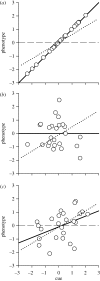Phenotypic plasticity and population viability: the importance of environmental predictability
- PMID: 20554553
- PMCID: PMC2982227
- DOI: 10.1098/rspb.2010.0771
Phenotypic plasticity and population viability: the importance of environmental predictability
Abstract
Phenotypic plasticity plays a key role in modulating how environmental variation influences population dynamics, but we have only rudimentary understanding of how plasticity interacts with the magnitude and predictability of environmental variation to affect population dynamics and persistence. We developed a stochastic individual-based model, in which phenotypes could respond to a temporally fluctuating environmental cue and fitness depended on the match between the phenotype and a randomly fluctuating trait optimum, to assess the absolute fitness and population dynamic consequences of plasticity under different levels of environmental stochasticity and cue reliability. When cue and optimum were tightly correlated, plasticity buffered absolute fitness from environmental variability, and population size remained high and relatively invariant. In contrast, when this correlation weakened and environmental variability was high, strong plasticity reduced population size, and populations with excessively strong plasticity had substantially greater extinction probability. Given that environments might become more variable and unpredictable in the future owing to anthropogenic influences, reaction norms that evolved under historic selective regimes could imperil populations in novel or changing environmental contexts. We suggest that demographic models (e.g. population viability analyses) would benefit from a more explicit consideration of how phenotypic plasticity influences population responses to environmental change.
Figures





References
-
- Both C., Bouwhuis S., Lessells C. M., Visser M. E.2006Climate change and population declines in a long-distance migratory bird. Nature 441, 81–83 (doi:10.1038/nature04539) - DOI - PubMed
-
- Bradshaw A. D.1965Evolutionary significance of phenotypic plasticity in plants. Adv. Genet. 13, 115–155
-
- Bradshaw W. E.1986Pervasive themes in insect life cycle strategies. In The evolution of insect life cycles (eds Taylor F., Karban R.). London, UK: Springer-Verlag
-
- Caswell H.1983Phenotypic plasticity in life-history traits—demographic effects and evolutionary consequences. Am. Zool. 23, 35–46
-
- Chevin L. M., Lande R.2010When do adaptive plasticity and genetic evolution prevent extinction of a density-regulated population? Evolution 64, 1143–1150 (doi:10.1111/j.1558-5646.2009.00875.x) - DOI - PubMed
Publication types
MeSH terms
LinkOut - more resources
Full Text Sources
